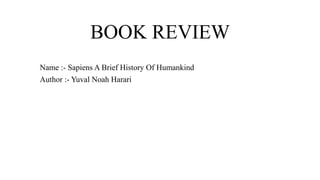
Sapiens
- 1. BOOK REVIEW Name :- Sapiens A Brief History Of Humankind Author :- Yuval Noah Harari
- 2. Content • Introduction • Cognitive Revolution • Agricultural Revolution • Unification of Humans • Scientific Revolution • Industrial Revolution • Past and Present
- 3. Introduction • From today about 2.5 million years ago in East Africa, Homo sapiens knows as • AUSTRALOPITHECUS evolved from apes, Homo sapiens were not the only one to survive. • Humans have evolved from different locations, like HOMO-NEANDERTHALS lived in the cold climate of Europe. HOMO-ERECTUS evolved from the tropical climate of Asia. HOMO-SOLOENSIS evolved from the islands of Java and Indonesia. Similarly, the same kind of species evolved from different origins. • But now Homo sapiens is the only major species dominating the Earth.
- 4. Cognitive Revolution • It started to happen with the development of our brains. • Homo sapiens who lived in East Africa, looked for food and shelter continuously . Henc, they used to hunt. In the beginning they were only a part of the food chain. They used to hunt for animals weaker than they were . Lions, tigers and shark were the king of food chain • But the discovery of fire changed the situation, Earlier they used to eat raw things, they took more time to digest. Hence,large teeth, large intestines, small brain size were present. After the discovery of fire they used to cook before they ate, it took less time to digest, small teeth, small intestines and brain size increase. • Their thinking got increased, to cooperate with others they developed language to communicate, and also improved hunting tools to kill strong animals. • Due to their social abilities, better mind and sign language sapiens within themselves cooperated with each other and also started killing the stronger animals. • Cognitive revolution lead sapiens to dominate the food chain. • When sapiens interacted with other breeds then two possible explanations were proposed by scientists Interbreeding theory :- sapiens bred with other species Extinction theory :- sapiens killed other species • Only one kind of sapiens remain i.e. Homo sapiens.
- 5. Agriculture Revolution • The evolution of agriclture took place almost at the same time in different places. The following places began to grow the respective food. Turkey:- Wheat, Rice and Millet North-America:- Corn, Beans South-America:- Potatoes Africa:- Millets China:- Rice, Millets Agriculture ead to the growth of respective food due to the presence of suitable animals. Like goat, pigs, cows and buffalo. • After 2000 years, all the sapiens species left hunting and started farming. • Farming is a very tough process. There are many steps involving hardwork such as sowing, irrigating, harvesting . That’s why sapiens started to settle at one place and their population started growing. • Before revolution they(sapiens) needed to travel for food and for that reason it was very difficult to feed their children with food but after the agricultural revolution women were able to grow more children and food was also available in large quantity • Agriculture revolution made sapiens more vulnerable and dependent. Then they started growing more crops. • Before revolution sapiens had small groups but after the revolution their population increased so they developed “imagined myths to cooperate in large number”. Like religion, god, laws and money. • Homo-sapiens started living in DUAL REALITY. Objective Reality like Nature, Rivers, Trees and Animals. Imagined Reality like God, Nation, Religion and Laws. Sapiens preferred more imagined reality than objective reality.
- 6. Unification of Humans • Slowly society got increased and their myths started growing more. Small cultures stared becoming mega cultures and to sustain mega culture empires were made. • MONEY, POLITICS AND RELIGION. • Money – Initially they started with Barter system but due to the large population the system got very complex. So in order to solve this problem they introduced money for exchanging goods. • Politics – King and his army ruled the different cultures and imposed them to follow a particular law. With this the king created a big common culture and destroyed the small cultures. • Religion – After the agriculture revolution, they started depending upon the climatic condition. So they imagined gods like rain god and fertility god. It created many gods in the community. • With this polytheism ,i.e., belief in many gods got increased. Monotheism that is belief in one god is derived from polytheism. Religions ike Christianity and Islam are missionary in nature which means that expansion of their religion is their motive.
- 7. Scientific Revolution and Rise of Europe • In 16th and 17th century, Europe had become the centre of scientific revolution. They believed that humans don’t know everything and desire to learn. Also, their capitalists sponsored research to conduct. • Very simple method were conducted for the research. First observations were collected and then used those observation to draw conclusions and equations. From this equation, in the 17th century Newton gave us the Newton’s Laws of Motion.
- 8. Industrial Revolution • First, humans burned wood for required energy. But later on, they started useing coal instead of wood. • Major changes came after the development of steam engine. Heat energy were converted into motion. • By this goods were created in Mechanised Production. • To transport humans to work Public Transport were created. • National Time were created to uniform Production and Trade.
- 9. Past and Present • After the achievement of all these revolution, are humans happy? Though they have good amount of communication tools but humans are emotionally alone. • The basic nature of humans are Hunter and Gatherer. • Coming technologies like Genetic Engineering, Nanotechnology, DNA Modification and Bionic Organs these concepts can change the evolution process. These concepts can change humans to superhumans.